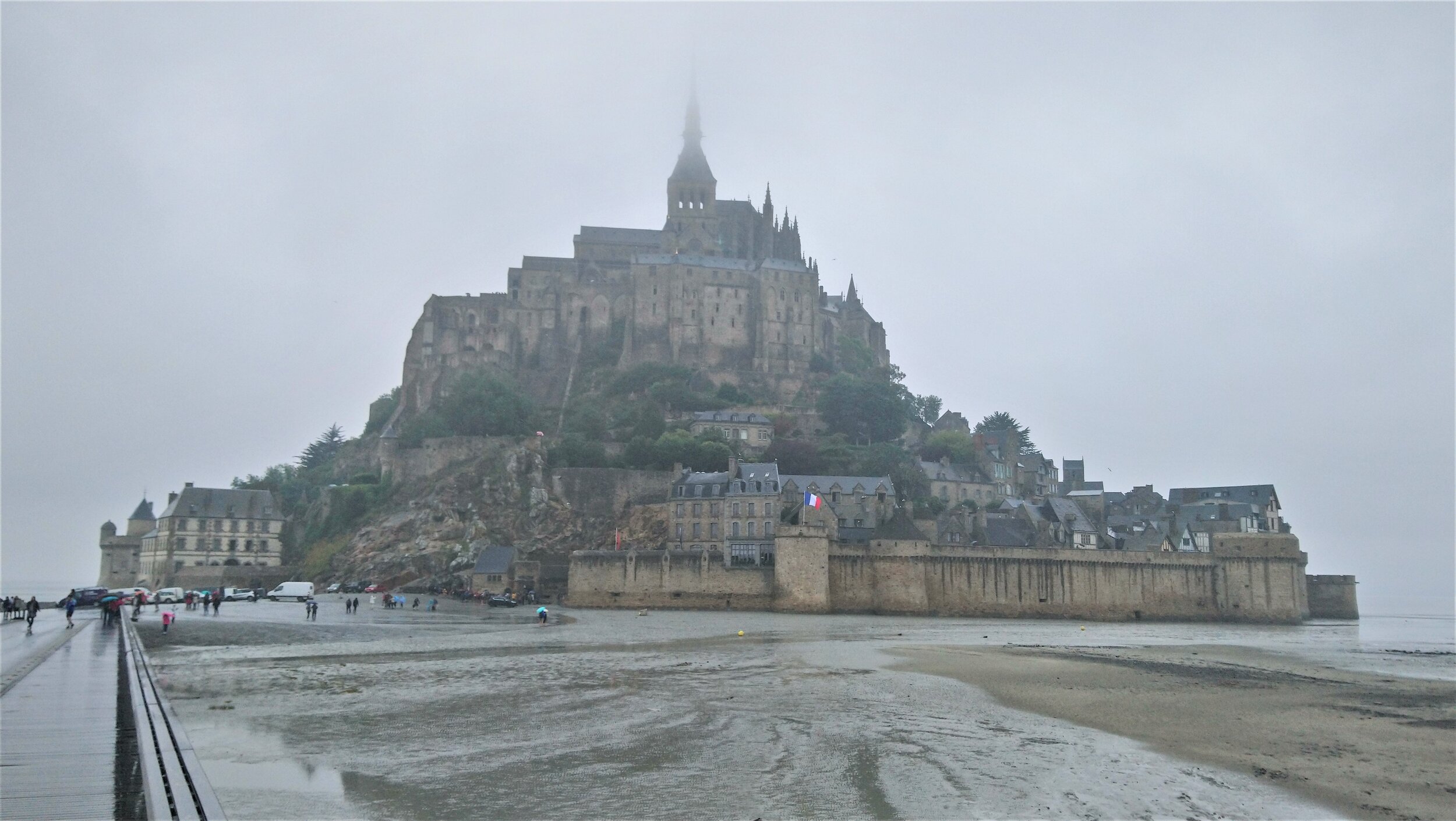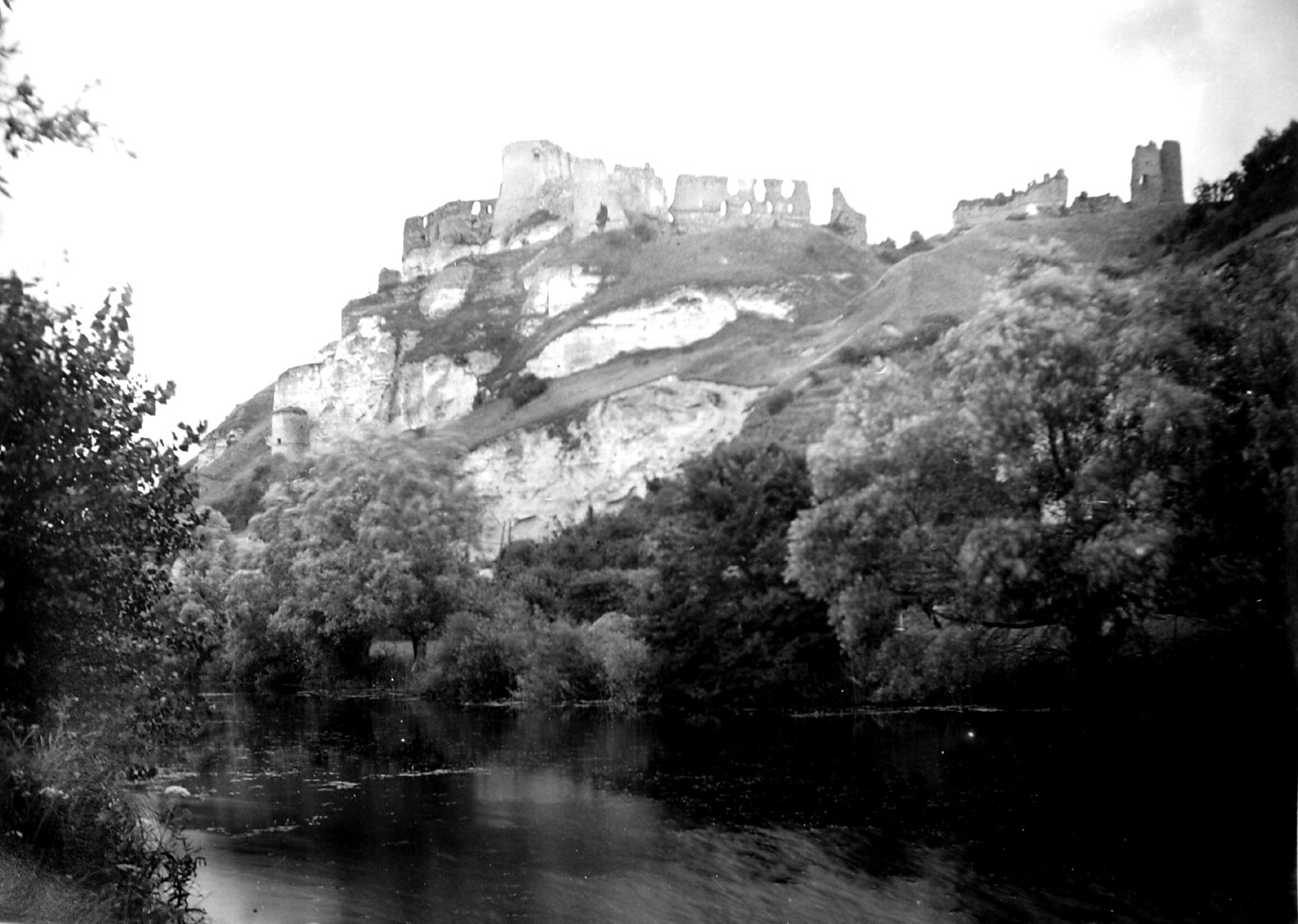The Mont is a tourist trap even if you avoid the restaurant. I weave my way up the main street through the hundreds of browsers, passing shops selling pennants, toy armour and miniature reproductions of our favourite gargoyles. The visitors are dressed in colours that the medieval lords and abbots of this place could never have conceived of - lurid pink, lime green and electric blue.
All around there is hefty stone – cobbles, steps, house walls, retaining walls, capping stones and slabs – in places the natural rock of the Mont protrudes, anywhere that’s too steep to build on. And on tired legs - my angry octopus has now disappeared - it feels alarmingly steep… Eventually I arrive at the abbey entrance. Even then there is yet another flight of stairs to make it to the ticket desk. It goes on and on.
The shape of the castle, a sort of cap on the rock, creates a mind-boggling network of stairways, corridors and walkways: they lead to you never know where: a cubby hole, a view of a dungeon or a dingy, vaulted corridor, but then the enclosed barrel of rattling echoes opens up into an enormous hall, a vast gallery where the shuffling and shushing of footfalls and voices echoes from scores of surfaces.
The original 11th Century abbey on the Mont was romanesque, but following a siege in 1204 it was rebuilt in Gothic style, and it is this that we see mostly now (you can spot a few remaining rounded arches). Mont St Michel reached its pinnacle as a place of pilgrimage in the 300 years following this reconstruction before it went into gradual decline over the following centuries. After the French revolution it even became a prison, at least partly for recalcitrant monks. It was only after reconstruction and restoration as a national monument in the late 1800s, by historical architect Edouard Courroyer (see Review of Mere Poulard’s restaurant), that it became a place of pilgrimage once again – this time for tourists as well as religious travellers.
In 1906, when the young TE Lawrence and his friend visited, it was still being restored by Courroyer, but evidently there was plenty for the two young men to explore. Lawrence writes that he will reserve judgement on the place -
“It is distinctly fine in parts. I will not say what struck me the first time, but will reserve description till third or fourth visit.”
- though in fact he does go on too voice a few opinions -
“All the nave is being restored, and the roof is therefore off; a fact which rather disfigures the rest of the church. The piscinas are horrid; tall, thin, about 16 inches wide, and eleven feet high. They are very ugly and ill proportioned.”
It is clear from the photographs he took the following year that it was the gothic arches that he found most picturesque. And the heart of it all is the cloister, with its double run of slender arches and niches containing carved faces and flowers. He took three images, showing the shapes and complex patterns that he enjoyed capturing – with gothic arches sliding behind one another in a repreating pattern of vaults. (See more about the young TE Lawrence’s photography.)
After a while comparing angles and aligning arches, I wander outside to a viewpoint - and find myself on a windblown hilltop of fractious kids and flyaway hairdos. Gulls are squawking, riding the wind all around us, and etched in the mud hundreds of feet below are meandering lines of footprints in the mud flats.
For all its aged wonder, the overall impression of these ancient halls and galleries is a little bald. It’s an issue with visiting almost all medieval buildings, as all trace of life seems to have evaporated (Falaise, William the Conqueror’s Castle has an innovative approach). But where it’s fun to explore a ruined fort, processing through the halls of a monastery in a herd of tourists leaves the building bereft of its soul, somehow. There is so little decoration that it is hard to picture the sense of human interaction. Instead I find myself admiring vast fireplaces - spaces large enough to roast an ox on a spit - and their thundering stone hoods angling into the walls. And Lawrence was right. The ceilings are impressive. They are a complex of juxtaposed arches, some hefty and solid - the Knights’ Hall, and the refectory - others intersecting as delicately as spiders’ legs. The ceiling of the Promenoir des Moines feels almost humanoid, like some sinewy structure inside an artery.
Down in the Refectory I find a sort of pulpit, where presumably a monk would have read excerpts from the Bible to his brothers who were otherwise eating in silence. Among the shushes and echoes the patrol of soldiers reappears, snaking among the crowd of browsers again. A bang sounds – momentarily I wonder if we’re all supposed to dive for cover - but in the second instant we realise that a heavy church door has slammed shut in the wind.
On the way down I walk the city walls. Presumably Lawrence and Scroggs, their serious work done, would have enjoyed this too - treading the ancient stones with the same view as a soldier from 800 years before them - but it is a measure of how intellectually bold, or perhaps how precocious the young Lawrence was that as he departs the Mont with such strong opinion. In his letter he writes:
“The insides of the buildings on the Mont are lovely; the outside is decidedly badly proportioned, with its dumpy spire, and flat masses of unrelieved masonry. I was horrified with the exterior.”
They were back in Dinard that night.
“Scroggs came back from Pontorson by train, but I rode, and thereby saved 3 francs 50 cent.”
Just a few days later, he returned to the Mont, with the Chaignon family.
“Off to Mont St. Michel tomorrow with the C's. I will ride. “
He doesn’t record any details of the visit, and lets just one thing slip in a letter to his mother: their concern for him as he cycled so far around the countryside.
“I alarmed all the family most terribly by going to the Mont without a hat: it was a cool cloudy day with a high wind, but they were excessively alarmed for my safety.”
The young Lawrence’s increasing capacity for physical endurance and his developing sense of adventure are the two main themes of this website and already he was beginning to display them in 1906. While not yet covering the sort of distances he would in each of the subsequent years (see more about his journeys in 1907, 08 and 09), the tendency was already showing itself as he turned 18. A few days after this he writes with a request.
“Have you any objection to my cycling to the Mont and back some moonlit night? I hear the views over the sands are sublime.”
For all the dumpy inadequacy of the abbey church tower, he was certainly enamoured of Mont St Michel. You can feel his excitement in a letter from 1907. In the summer holidays just before he went to university, he was back there again, this time with his father’s camera strapped to his bicycle. He had been in Dinan photographing the town and the Rance River and rode to Mont St Michel via St Malo:
“DEAR MOTHER
Here I am at last about to spend a night at the Mont. The dream or years is fulfilled. It is a perfect evening; the tide is high, and comes some 20 feet up the street. In addition the stars are out most beautifully, and the moon is, they say, just about to rise. The phosphorescence in the water interests me especially: I have only seen it once or twice before, and never so well as tonight. The whole sea, when oars are dipped into it, seems to blaze, for several feet around.”























